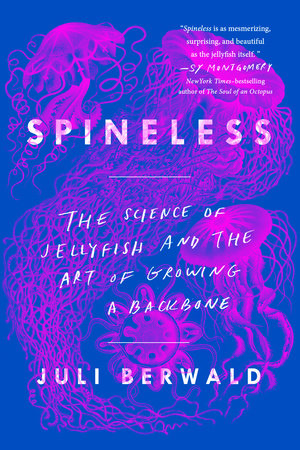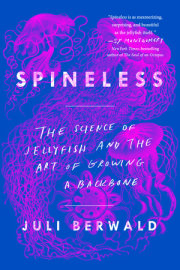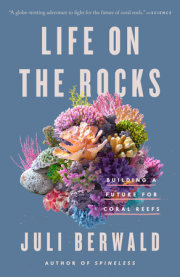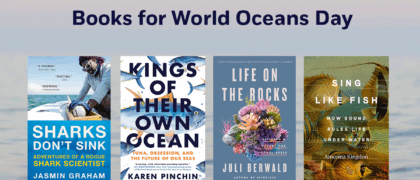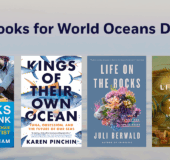1
If You Dare
Hiroshima's downtown is a garden of modern architecture interspersed with swaths of lovely green parks. In the center, there is a single structure, in ruins, capped by a skeleton of curved iron. This is the Atomic Bomb Dome, located at the destruction's epicenter, the sole building that managed to remain standing amid the massive force that flattened everything else for miles in all directions. It is an astonishing memorial to both our capacity for horrifying devastation and our awesome resilience. The dome sits along the side of one of six tidal streams that flow through Hiroshima. In the murky, green water, I watched thousands-maybe hundreds of thousands-of pale pink disks parade by, a flood of jellyfish. Juxtaposed with the dome, the endless stream of jellyfish seemed to square off nature's power against our own, a battle as old as civilization that continues to play out in the decisions we make today. They were the first wild jellyfish I saw in years of chasing jellyfish. The milky creatures pulsed slowly, slower than my heartbeat, which dropped as I watched. The movements of their bells trailing gossamer tentacles were like millions of eyelashes blinking open and closed and open again, giving me a feeling that these alien animals could peer deep into the soul of the sea. I found it impossible to fathom the source of this endless river of life. The jellies continued to flow by for as long as I stood and watched.
Maybe you remember the first time you saw a jellyfish. Maybe you were lucky enough to stick your head under the ocean's surface, wearing a mask, and watch the primal undulations of a jellyfish dancing to some internal rhythm. Maybe you felt a biting sting in the water and turned to see a gelatinous blob disappear like sinking mucus. Maybe you stood against the glass and watched the elegant clover on the back of a moon jellyfish or the graceful train of a sea nettle in an aquarium. Or maybe it was footage of jellyfish hawking a cure for memory loss.
I don't remember the very first jellyfish I saw. I grew up in a time before aquaria were full of jellyfish tanks, in a very landlocked in St. Louis. I never spent an extended period near the ocean until I was in college. In my junior year, 1987, I attended an English-speaking study-abroad program in Tel Aviv. From a New England school where getting ready to go to a party meant putting on tattered jeans, a flannel shirt, and duck boots, I was a misfit among the other American students, who were a lot less style-challenged. I found the Israelis my age no easier to get along with. At nineteen, they were required to serve in the army, while I had the freedom to jaunt off to college unencumbered.
I stuffed my loneliness down with the hummus and baba ghanoush sold from a cart on the street corner near my cinder-block dorm. At about the same rate that my weight increased, my spirits sank. One day, I opened the door to the building where my class on Middle Eastern politics was held and spotted a sign out of the corner of my eye. It advertised a marine biology course: a week in Eilat, at the southern tip of Israel, studying the ecology of the Red Sea. Knowing next to nothing about biology or Eilat, not to mention the fact that I was hardly able to squeeze into my swimsuit anymore, I scrawled my name at the bottom of the list. It was clear I needed to put some distance between me and the pita cart.
A few days later, with about twenty other students, I boarded a bus headed south at dawn. After a five-hour ride through the desert, we were offloaded and handed snorkels, masks, and fins. I think there was a quick instruction on keeping hands away from urchin spines and fire coral. I shuffled down the beach backward, the only way to walk in fins. When I slipped my face below the water's surface, it was as if I were Dorothy stepping into Oz. My dull, sad world erupted in a kaleidoscope of colors, shapes, and textures. I glided over creatures that I could never have imagined existed in my mostly inland life. Pink, purple, and yellow coral that branched, encrusted, and mounded. Blotchy lavender anemones, creeping crimson shrimp, twirling buff-colored worms, filigreed fans, spiked black urchins. A day-glo orange sponge with a violet slug curled around it. Bowls of lemon-, lime-, and watermelon-hued clams. Here, astonishingly, was paradise.
That evening, the professor gave a lecture detailing twenty different species of coral living on the reef. He told us to memorize them all. Walking to the dorms after class, gazing at the moon's reflection on the Red Sea, I felt, for the first time in a long time, happy.
Within days, I learned not only to recognize and identify the twenty different coral species, but to understand how they got along on the reef. I laid out thirty-foot lengths of rope and measured the space each colony occupied along the line. I watched coral engage in territorial feuds when their delicate tissues grew too close together. I learned to recognize the winner as the one whose threadlike stinging cells outnumbered those of its foe. It was a contrast to the battles that destabilized the Middle East: I found truth and beauty in these miniature clashes, which brought balance to the ecosystem.
By the time I climbed back on the bus to Tel Aviv, marine biology had sunk its hooks deep into me. I felt that the intricate dynamics of the ocean were more deeply authentic than anything humans could create. Seven days of snorkeling and studying coral all day and then peering into microscopes at constellations of plankton deep into the night taught me that biology is the foundation of our world, the stuff that is not changed with the whims of humans. Its heritage, so much more ancient than our own, gave it the gravitas I'd been searching for. Studying this scaffolding on which we hang our existence was what I wanted to do with my life.
After that first mind-blowing dive in Israel, I did go on to study ocean science in graduate school. And that's probably the first time I saw a jellyfish. A few years after my work on jellyfish started, I dug out my old box of grad-school memorabilia. And in a cardboard clamshell of old slides, the kind you have to stick into a projector, I found a hazy picture of what I now know was a compass jellyfish, taken in Puget Sound. I don't remember taking it. In grad school, I didn't work on jellyfish or any other marine animal. I worked on the equations satellites use to tell us how much carbon dioxide the ocean can inhale. That was the big picture, anyway, the kind of thing I told my parents so they could repeat it to their friends. The reality was much more obscure. I studied a single variable in those equations, one that only about a dozen people in the world recognized.
After moving to landlocked Austin, Texas, with my husband, I glumly slipped off the academic path and found my way into writing textbooks. It worked well when my two kids were young and I was always sleep deprived. But state-mandated academic standards soon quashed any sense of passion about the work. I had written and rewritten the same chapters on the physics of tossing balls into the air and dropping rocks off cliffs, on the bending and reflecting of waves, for nearly a decade when a friend gave my name to an editor at National Geographic. They needed a writer to pen three paragraphs on the physics of water bugs skating up a meniscus. After it was done, I spotted the magazine on a grocery store rack. Flipping to my tiny byline to show the cashier, I crowed, "That's me!"
Despite my small successes in the print media and my semi-stable textbook gigs, when I slowed down enough to think, I felt lost. Although I looked good on paper, and maybe Facebook too, I knew I was actually adrift, aimlessly riding currents over which I had no control.
The technical name for the stage of a jellyfishÕs life when it swims freely in the seas is medusa, a moniker shared with the ancient Greek mythological monster. Medusa is famous for her horrible face, which could turn a man to stone, and her wild locks of hissing snakes. ItÕs not hard to see the similarities. A swimming medusa could look like a floating head with a wayward mane of terrifying stinging tentacles.
But dig a little deeper into the story of Medusa, and what you find is not at all a monster, but a victim whose story has been misunderstood. Medusa was born to two ancient marine deities and, according to Ovid, was stunningly gorgeous. She served the goddess Athena in her temple. Some say she was a temptress and lured Poseidon into Athena's temple. Others say Poseidon couldn't control himself. As in too many cases like this, it depends who's telling the story. Since I am: He raped her, right there in Athena's temple.
Because it was ancient Greece, Medusa had little recourse. Athena went into a rage that her temple had been defiled, turned Medusa into a hideous monster, and kicked her out. Medusa-who deserved at least a shoulder to cry on, if not justice in a court-instead banished herself to a remote island, frightened and deformed. Imagine her disgust, shock, and horror to find that she was also pregnant with her assailant's offspring. To complete the tragedy, the man always regarded as a hero, Perseus, arrived. Using the tricks of the gods-an invisibility cloak, winged sandals, and a mirrored shield-he snuck up on Medusa. She never had a chance. He murdered her.
From her severed neck, twin newborns emerged. The first was Pegasus, the winged horse, who flew up to the heavens. The other was Chrysaor, a giant who carried a golden sword. Today, a group of golden-brown jellyfish species known as sea nettles, some of which can grow to three feet across, is among the more common jellyfish groups in the oceans. Their name honors poor Medusa's child. The genus is called Chrysaora.
Like their mythical namesake, jellyfish are also awash in misunderstanding. They have no centralized brain, but they see and feel and react to their environment in complex ways. Their body form looks simple, yet their swimming ability is the most economical in the animal kingdom. We know them in their swimming medusa form, but they live as much or more of their lives as a mysterious tiny tube planted on the underside of a rock. They wash ashore in hordes, and they dominate the deepest depths of our planet, supporting entire ecosystems. And still, scientists are unable to predict where and when to find them. To some, jellyfish symbolize the monster-not only in their potentially lethal sting, but also in a more global sense, as a symptom of ecosystem demise. At the same time, jellyfish are utterly, breathtakingly beautiful. As we watch the primal undulations of a medusa, they harmonize with the beats of our own hearts. Perhaps the extraordinary creativity of this balance, this surprising ability to exist in the space between monster and goddess, is why jellyfish resonate so deeply within all of us. Perhaps the story of jellyfish is really about our own possibilities.
I stumbled onto jellyfish, not while snorkeling or visiting an aquarium but while working with National Geographic photographer David Liittschwager. David is recognized for his close-up shots of marine organisms nearly always posed on a simple background of white or black. Once, when I asked him about the style, he said he used the plain background because it allows the observer to regard the animal as an individual. And it does. Staring at a shot of a solitary snail whose dark eyes peer out from under a pearly white shell or a nearly transparent octopus whose arms are coiled in symmetric spirals, you realize that every living creature on our planet tells a unique millennia-long success story worthy of our consideration.
The piece David was working on at the time was on ocean acidification, which is known as global warming's evil twin. The oceans have sucked up about 28 percent of the carbon dioxide we've emitted from burning fossil fuels over the past two and a half centuries. When carbon dioxide mixes with water, it forms carbonic acid. With more carbon dioxide in the atmosphere, there's more carbonic acid in the ocean. Acid dissolves shells, and many marine creatures have shells: coral, crabs, snails, lobster, shrimp, urchins, sea stars, even some worms. The ocean is now 30 percent more acidic than it was when the first Model T rolled off the assembly line a century ago.
As I scanned the story layout, I saw a quintessential National Geographic chart called "Winners and Losers." On the losers' side were creatures with shells: lobsters, crabs, sea stars. That made sense. Shells dissolve in acid seas.
On the winners' side were shell-less things: algae, worms, and jellyfish. Jellyfish? I'd always thought of jellyfish as delicate. What was their protection against acidified surroundings? I was curious. Delving into scientific literature, I found that drawing connections between jellyfish and today's more acidic seas was not simple. Strikingly few experiments on jellyfish in future ocean conditions had been done. A few studies had shown that warmer temperatures increased the growth of the planted tube part of the jellyfish life cycle called the polyp. One study had shown that these polyps fared poorly in water with low pH. One had shown they could survive polluted conditions. But that seemed meager evidence. I delved deeper.
I found fascinating stories about jellyfish all over the globe. Beginning in 1963, off Namibia in southwestern Africa, jellyfish started dominating the ecosystem, depressing what had been one of the world's most productive fisheries. Today, those waters are a sea of goo. In the Black Sea, populations of a comb jelly imported from the Atlantic in ballast water exploded into the millions, causing hundreds of millions of dollars in economic losses until its predator, another comb jelly from the Atlantic, was imported too. In Japan, the presence of the giant jellyfish was recorded only three times during the twentieth century. It has appeared regularly in the twenty-first, and in 2009 accounted for a massive aggregation of jellyfish, known as a bloom, the largest in recorded history. In the Philippines, jellyfish clogged the cooling system of a major power plant, causing a blackout that was mistaken by some as the start of a military coup. The largest lagoon on Spain's Mediterranean coast, called the Mar Menor, had always been home to jellyfish, but in the 1990s the numbers inflated. The jellyfish grew so thick in 2002 that you couldn't drive a boat through the water.
Were these changes a symptom of a changing planet? Or were they just natural cycles that we’d failed to see because we weren’t looking? Answering that question is complicated because jellyfish have been historically understudied by scientists. Except for rare allocations, like the Jellyfish Act of 1966, which provided funding to study sea nettles in the Chesapeake, there had not been concerted effort to understand jellyfish and their roles in ecosystems.
So, tempting as it was to draw conclusions, some scientists cautioned we might not have enough data to do so. In a 2008 paper on jellyfish and acidification, Steve Haddock, a jellyfish researcher at the Monterey Bay Research Institute in California, chastened at other researchers who were drawing connections between jellyfish and the climate. “Broad statements about global warming and climate change are likely to garner a great deal of attention, and thus should be held to a relatively high standard of analytical rigor,” he wrote. “. . . . [B]ecause research of this kind can have lasting policy implications, it is important not to attribute all perceived ecological change to ‘global warming’ or ‘ocean acidification’ without reasonable evidence from an appropriately broad data set.”
Amid the usual staid scientific results and discussion, here was language that appealed to scientists to steer clear of sensationalizing, even as the words acknowledged that jellyfish were gaining some sort of new scientific status. The passage made me think jellyfish had an important story to tell. And it turns out, they have many.
Copyright © 2018 by Juli Berwald. All rights reserved. No part of this excerpt may be reproduced or reprinted without permission in writing from the publisher.

